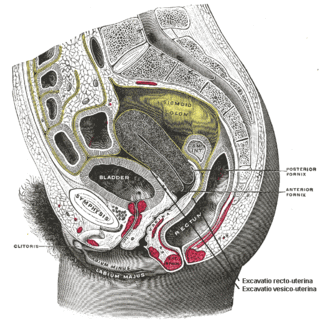Techniques
Non-surgical vagina creation was used in the past to treat the congenital absence of a vagina. The procedure involved the wearing of a saddle-like device and the use of increasing-diameter dilators. The procedure took several months and was sometimes painful. It was not effective in every instance. [2] Uncommon growths, cysts, septums in the vagina can also require vaginoplasty. [19]
Reconstructive surgery after cancer treatment
Radiological cancer treatment can result in the destruction or alteration of vaginal tissues. Vaginoplasty is often performed to reconstruct the vagina and other genital structures. In some cases, normal sexual function can be restored. [3]
McIndoe surgical technique
A canal is surgically constructed between the urinary bladder and urethra in the anterior portion of the pelvic region and the rectum. A skin graft is used from another area of the person's body. The graft is removed from the thigh, buttocks, or inguinal region. Other materials have been used to create the lining of the new vagina. These have been cutaneous skin flaps, amniotic membranes, and buccal mucosa. [3] [9]
Gender-affirming surgery
Several techniques may be used in gender-affirming surgery to create a neovagina.
Penile inversion
Inversion of the penile skin is the method most often selected to create a neovagina by surgeons performing gender-affirming surgery. The inverted penile skin uses inferior pedicle skin or abdominal skin for the lining of the neovagina. The skin is cut to form an appropriate-sized flap. The skin flap is sometimes combined with a scrotal or urethral flap. [4]
The penile inversion technique was pioneered by Georges Burou in his Morocco clinic in the 1950s. [20] By the 1970s he had performed hundreds of them, and gave his first public presentation of his technique to a conference at Stanford University in 1973, [21] after which it gradually became the predominant technique worldwide.
Bowel vaginoplasty
Bowel vaginoplasty is another commonly used method to create a neovagina in gender-affirming surgery. [4]
Other methods
Penile-scrotal skin flaps are also used. Nongenital full-thickness graft (FTG) or split-thickness skin grafts from other parts of the body have been used.[ citation needed ]
Elective vaginoplasty
Critics have labeled such surgery as the "designer vagina". The American College of Obstetricians and Gynecologists issued a warning against these procedures in 2007 [22] as did the Royal Australian and New Zealand College of Obstetricians and Gynaecologists, [23] and a commentary in the British Medical Journal strongly criticized the "designer vagina" in 2009. [23] [24] The Society of Obstetricians and Gynaecologists of Canada published a policy statement against elective vaginoplasty based upon the risks associated with unnecessary cosmetic surgery in 2013. [25]
The World Health Organization describes any medically unnecessary surgery to the vaginal tissue and organs as female genital mutilation. [26]
Vaginal rejuvenation is a form of elective plastic surgery. Its purpose is to restore or enhance the vagina's cosmetic appearance. [24]
Hymen surgical procedures
An imperforate hymen is the presence of tissue that completely covers the vaginal opening. It is cut to allow menstrual flow to exit during a short surgical procedure. [1] A hymenorrhaphy is the surgical procedure that reconstructs the hymen.
Balloon vaginoplasty
In this procedure, a Foley catheter is laparoscopically inserted to the rectouterine pouch whereupon gradual traction and distension are applied to create a neovagina.[ citation needed ]
Pull through or Vecchietti procedure
In treating Müllerian agenesis, the Vecchietti procedure is a laparoscopic surgical technique that produces a vagina of dimensions (depth and width) comparable to those of a normal vagina (ca. 8 cm deep). [27] [28] A small, plastic sphere called an olive is threaded (sutured) against the vaginal area; the threads are drawn though the vaginal skin, up through the abdomen, and through the navel. There, the threads are attached to a traction device, and then daily are drawn tight so that the olive is pulled inwards and stretches the vagina, by approximately 1 cm per day, thereby creating a vagina, approximately 7 cm deep by 7 cm wide, in 7 days. The mean operating room (OR) time for the Vecchietti vaginoplasty is approximately 45 minutes; yet, depending upon the patient and her indications, the procedure might require more time. [29] The outcomes of Vecchietti technique via the laparoscopic approach are found to be comparable to the procedure using laparotomy. [30] In vaginal hypoplasia, traction vaginoplasty such as the Vecchietti technique seems to have the highest success rates both anatomically (99%) and functionally (96%) among available treatments. [31] [19]
Other surgical techniques that have been developed include ileal neovagina (Monti's technique), Creatsas vaginoplasty, Wharton–Sheares–George neovaginoplasty, or the Davydov procedure. The most widely used is the Vecchietti laparoscopic procedure. Sometimes sexual intercourse can result in the dilation of a newly constructed vagina. [9]
Vaginal dilators and expanders


The most techniques of vaginoplasty are using inflatable vaginal expanders or vaginal stents to design the vaginal diameter and length. [32] [33] At the end of the procedure the device stays in place to maintain the neovagina against the pelvic wall which also favors the process of microscopic neovascularization and reduces the risks of hematoma. In post-operative setting the expander can be used regularly to prevent post-operative vaginal retraction. [34] Solid vaginal dilators can also be used immediately after surgery to keep the passage from attachments, and regularly thereafter to maintain the viability of the neovagina. The frequency required to use decreases over time, however remains obligatory lifelong. [35] [36]











